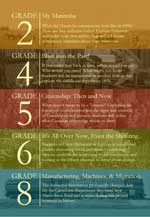 Program Description
Program DescriptionWhat does it mean to be a “citizen?” What rights do citizens have the non-citizens do not? As life in Canada has changed overtime, so have the rules and rights of citizenship. What does being a Canadian citizen mean to you? What was it like to be a citizen at Confederation? What about if you weren’t a citizen? Exploring the history of confederation and the signs and symbols of Canada past and present, students will define what Canadian citizenship means to them.
To encourage children to think critically about their rights and responsibilities as citizens of Canada. To invite children to examine the history of citizenship in Canada, noting where there was inequality in the past and where it currently exists in the present. To provide students with the opportunity to define and express how they interpret their Canadian citizenship.
Social Studies
5.4.4
Negotiating Confederation5.4.5
Citizenship Then and NowKL-022 Locate on a map of Canada the four provinces of Confederation in 1867
KC-001 Give examples of the responsibilities and rights of citizens of Canada in 1867
KH-041 Describe the origins of Confederation and give arguments for and against Canadian Confederation.
Include: Significance of the British North America Act; resistance of Prince Edward Island, Newfoundland, and Nova Scotia to Confederation
KC-002 Identify differences in citizenship rights for various groups in 1867
Include: First Nations, French, British, women
KH-042 Describe the roles of individuals in building Canadian Confederation
Include: John A. Macdonald, Georges Etienne Cartier, Charles Tupper, Thomas D’Arcy McGee, George Brown, Samuel Tilley, John H. Gray
KC-003 Compare what it meant to be a citizen of Canada in 1867 to what it means today
VH-010 Value history as a way of understanding contemporary Canada
English Language Arts
5.1
Develop and Celebrate Community5.1.1 Compare Responses
Acknowledge differing responses to common experiences.
5.1.2 Relate Texts to Culture
Draw on oral, literary, and media texts to explain personal perspectives on cultural representations.
5.1.3 Appreciate Diversity
Compare individuals and situations portrayed in oral, literary, and media texts to those encountered in real life; recognize personal participation and responsibility in communities.
Component
Time (minutes)
Description
1. Introduction
10
Students are introduced to Dalnavert with emphasis placed on its connection to Sir John A. Macdonald. Students are led in a discussion about Confederation, citizen rights in 1867 and citizen rights in present day, and the history of Manitoba joining Confederation.
2. Trunk Activity
15
Students handle authentic and replica objects connected to Sir John A. Macdonald and Confederation and draw conclusions based on the objects. Primary and secondary sources are defined.
3. Tour
30
Students are led on a tour of the house focusing on the ties to Sir John A. Macdonald, Confederation, settlement in Manitoba, and the rights of Manitoba citizens at the Turn of the Century.
4. Flag Activity
30
Students brainstorm signs and symbols of Canada and make their own flag for Canada using symbols they feel reflects what being a Canadian citizen means to them.
5. Conclusion
5
Major points of the day are recounted and final questions are answered.
Page revised: 19 February 2012